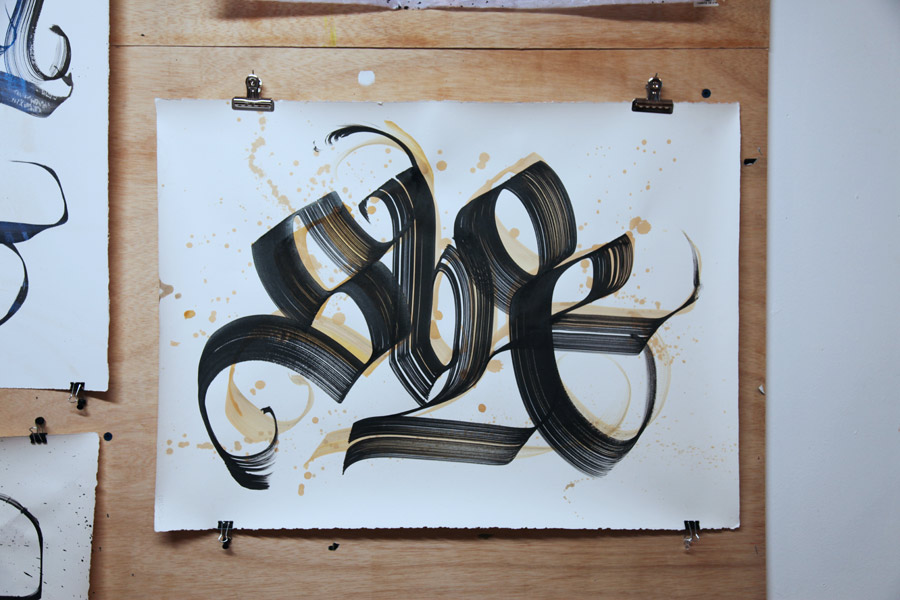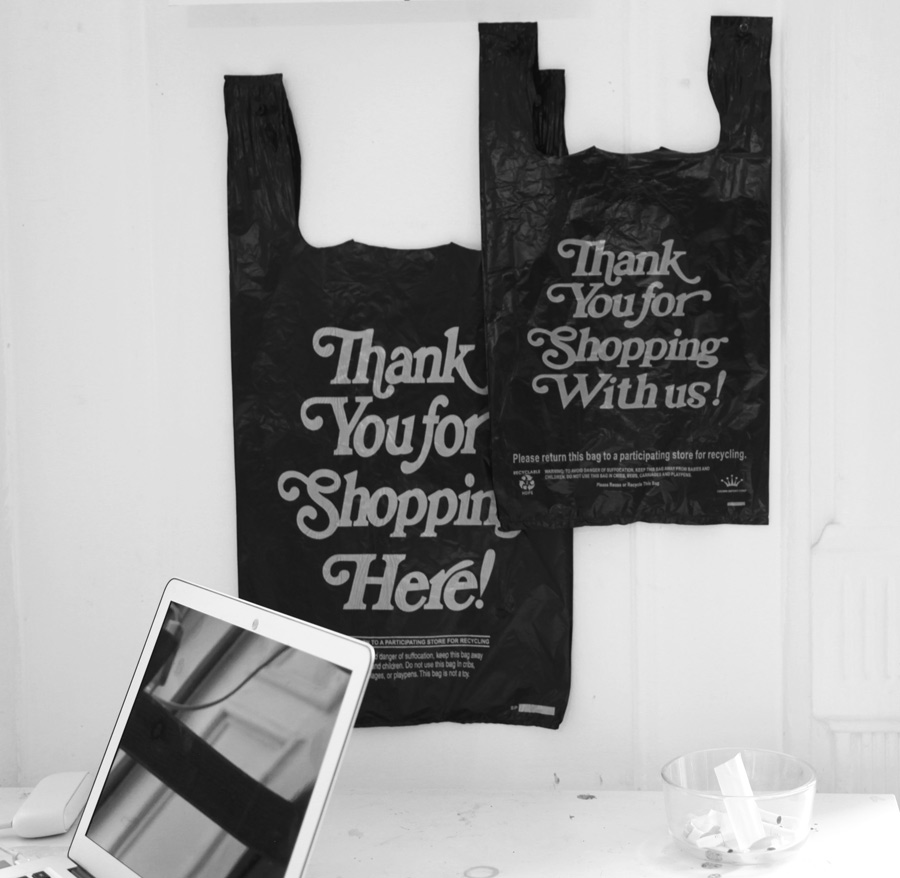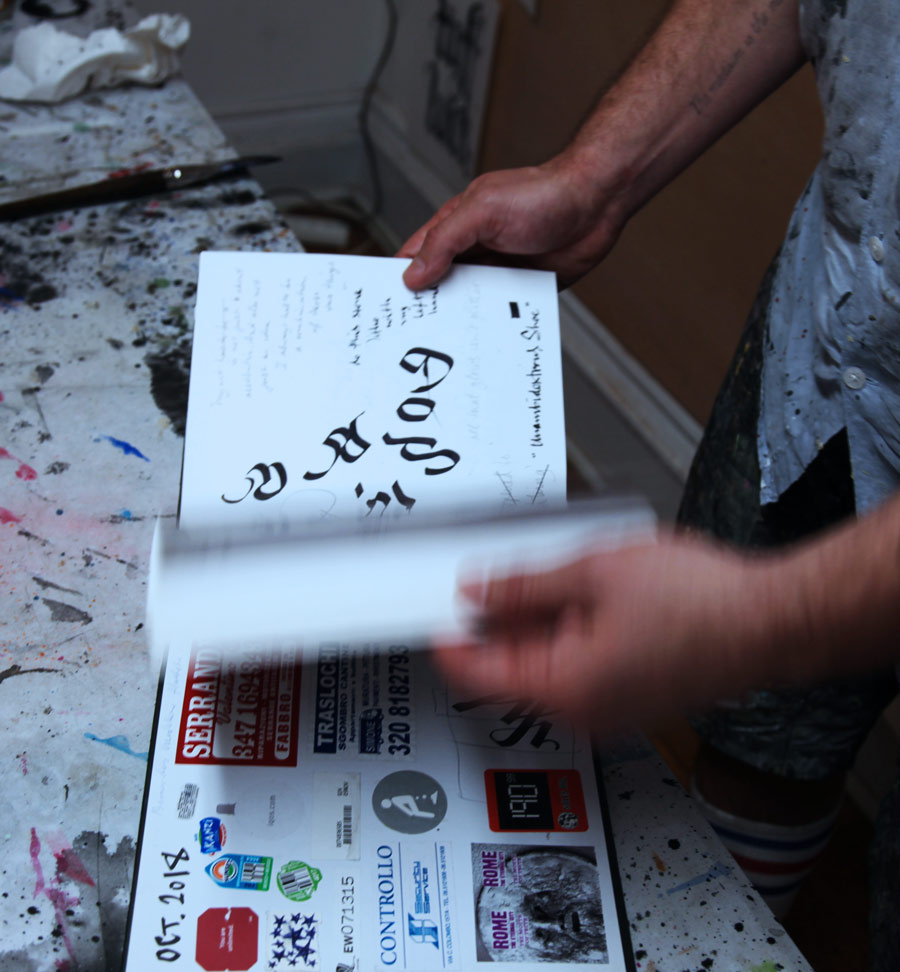Graffitti. Calligraphy.
Both celebrate the power and expressive ability of the letterform and yet each appear as entirely separate pursuits. Uniting them requires understanding both very well, contemplating their friction, their possibilities, and a lot of negotiation.

Since 2007 Niels “Shoe” Meulman has been investigating, experimenting with, enraptured by this pursuit. From thousands of hand sketches in his black book to the full-body immersion techniques of creating across large walls and floors, using paint and brush by the gallon in premeditated/subconscious all-inclusive gestural choreographies. Shoe knows how to stay in the moment.
It’s this elevating together of disciplines that reveals their contrasts; awakening the inner conflicts and core strengths, parading them on view.

He discovered the perfect transmutation here in Brooklyn. It was that night of art-making with Haze that was a turning point..
“We both decided to go to the art store and get a whole lot of tools and stuff and just started working to see what would come out,” he says as he glances out the
“Without a commission, without a brief,” he remembers. “And like that – my old passion, calligraphy, mixing with graffiti, just came out!”

Shoe says he created “calligraffiti” and he ran with it: developing a body of work around it, writing a book about it (Calligraffiti), collaborating with a growing number of artists who also had an affinity for the penmanship of an artful communication modality that spans centuries.
He has developed brushes, tools, techniques, opened a gallery in a garage (Unruly), covered surfaces from cars to museum walls, finished three more books (Painter, Abstract Vandalism and Shoe is my Middle name). It was as if he had finally decided at 40 that it was okay to be an artist, and he left advertising to dedicate himself fully to his craft.

“Because my dad is also an artist- maybe I was finding the right moment to be an artist,” he says as he shows you a stack of many papers from the art supply store, and he contemplates why he had hesitated for years. It’s not that he was concerned about competing with his father, but the stakes were high. Speaking of his father, he says, “I think he was thinking ‘if you’re going to be an artist you better be a successful one’ – because being a struggling artist – that’s the worst!”
Additionally, he thought that before he could call himself an artist, he should have something substantial to show. “It also felt like there was something more profound to it,” he says. “I always thought that to be an artist you have to have life experience and have some knowledge and purpose to bring to the table, you know?”

Whether wide tip, wide brush, or wide cap, the bending letters are cryptic and stern in their old-worldliness. Fluid and stilted, wild and ornate, gilded, in black, in

With broad interests that delve into abstract, into wordplay, even poetry, this moment is the clarity in early morning fog on a quiet street in old BedStuy, now rumbling with the sweet sickness of gentrification. The residency that brings him here is so named to recall history and to look forward, offering a respite for many a visiting Street Artist.
“I didn’t really have a plan when I came here but, like many times, I come up with something on the plane like the day before – and of course it’s brewing in my head.”

He points to a couple of handled black plastic shopping bags that he has tacked to the wall. With a capacity to recognize and understand his own emotions and the emotions of an era, he has connected to the pleasantry printed on them “Thank You for Shopping With Us!”. It’s not just the sentiment that captures the late 1970s design hand, for him, it’s the upbeat openness and lyrical bending of the letters and lines that attract him.
The letters are sweet like cherry lip-gloss on a rollerskater in hot pants in Central Park. Suddenly you are flipping through the pages of Eros, Fact, or Avant Garde, a relief of melodic line and sexual liberty.

“Thank you for shopping!” he exclaims like a fan. “That’s so New York for me; that’s exactly graffiti – that 70s Herb Lubalin look,” he says of a time when magazines were so head-over-heels in love with new type treatments that they might feature a 2-page spread of it entirely just for you to salivate over.
“It’s free,” he says, perhaps reflective of the liberal sway of social mores and the swinging romance that advertising had with the Baby Boomer’s ‘me’ generation of the seventies. It’s a phrase rooted in consumerism, cities were in the last throes of an ample middleclass America who had cash and credit to shop with. That fact contrasted with the suffering of a bankrupt NYC – a spirit that inspired train writers as well, even if used as critique.

“I think the whole graffiti scene that started here had something to do with this sort of lettering,” he says. “It came from that freedom that you could see in advertising. The

For now, this month-long residency is a reprieve for Shoe, a time to examine and relax into the spring that gradually warms New York and brings rose blooms to the bush in the small front yard of this residential street. His new sketches from his black book contain pithy barbs, hidden meanings, pop-culture references, and life truisms drawn in what he might refer to as a monk-like manner.
“I’m not religious. I don’t follow any religion and I don’t meditate but I like this idea of knowledge and introspection,” he says. “This is where Chinese calligraphy comes in and you are reminded of the medieval monks and all kinds of calligraphers”.

A congenial host, Shoe shows
“That knowledge comes from that kind of introspection. The influence of Japanese and Chinese calligraphy comes in because at that time if you were by yourself writing…. Those monks either wanted to be enlightened or were enlightened in some way; it’s a search,” he says.
“This is where I am.”





To learn more about the BedStuy Art Residency, please go HERE.
Other Articles You May Like from BSA:
For many the shock of Silent Spring was not that the chemical industry had run roughshod over the rules and poisoned our water, air, and soil. For a large number of readers it was the fact that Rache...
This week BSA is in Madrid to capture some highlights on the street, in studio, and at Urvanity 2019, where we are hosting a 3 day "BSA TALKS" conference called "How Deep Is the Street?" Come wit...
Our weekly focus on the moving image and art in the streets. And other oddities. Now screening : 1. Icy & Sot Overview2. Imaginary City. Teaser from MZM Projects (UA)3. "Martha Cooper: Ev...
Famed graffiti and street art photographers Martha Cooper and Nika Kramer took to Jacó, Costa Rica, during the winter holidays in December, proving that they knew where to go when the weather up Nort...
There is a lot you can do in Mong Kok, one of the most commercial and bustling neighborhoods in the Kowloon section of Hong Kong. There’s the Ladies’ Market with more than 100 vendors offering bargain...
 BROOKLYN STREET ART LOVES YOU MORE EVERY DAY
BROOKLYN STREET ART LOVES YOU MORE EVERY DAY










